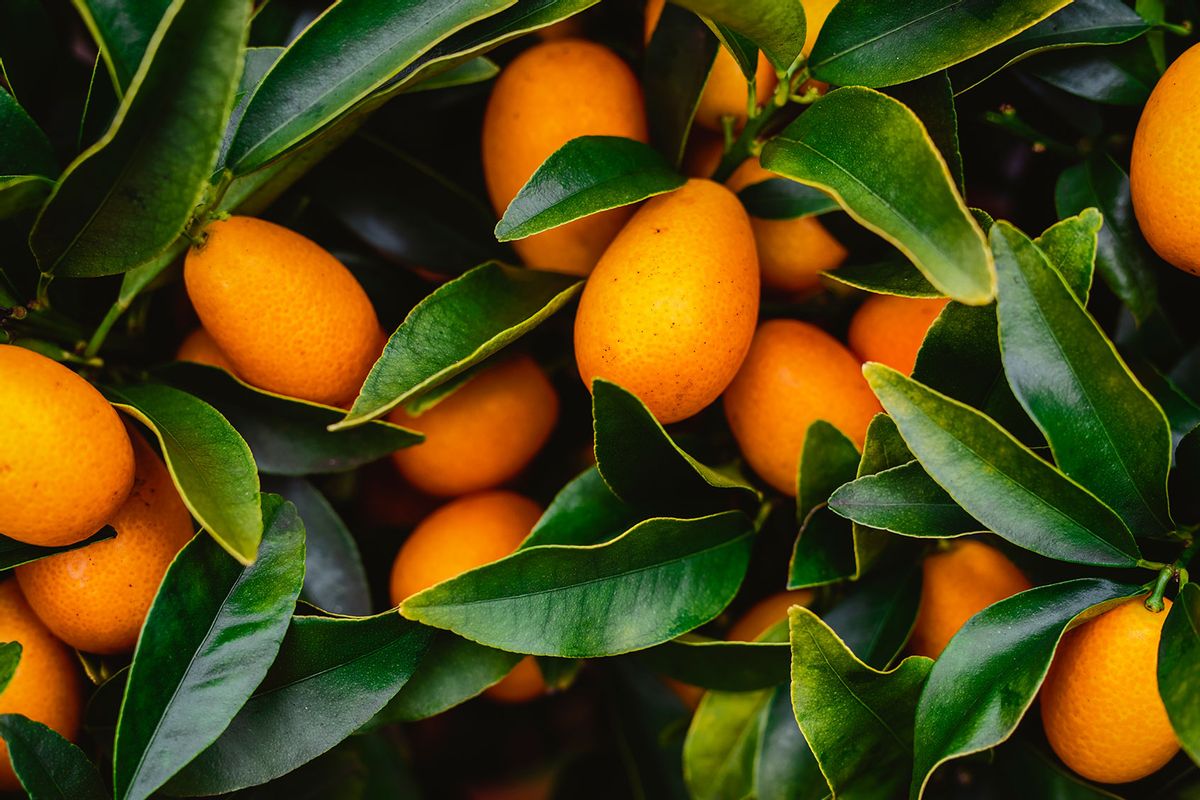A guide to winter citrus varieties

It’s citrus season in the U.S., and if you live along the citrus belt — the string of states that hug the southern border from California to Florida — a bevy of fresh local oranges, lemons, kumquats and so much more are showing up in your farmstands. For everyone else, these fruits make a longer journey to enliven the dwindling selection of storage apples and pears in produce aisles, bringing some welcome variety to our diets. If you’re lucky enough to have a relative in a citrus-growing state, you likely have received shipments of fresh fruit as a gift; if not, order your own! Companies that specialize in mail order abound; but since some conventional citrus is a pesticide-heavy, especially tangerines and grapefruits, check out growers that specialize in certified organic, like Frog Hollow Farm.
According to Tracy Kahn, curator of the Givaudan Citrus Variety Collection at the University of California, Riverside, which has 1,000 different cultivars or citrus and related species, relatives of the citrus varieties we know today likely originated in Yunnan Province in China elsewhere in Southeast Asia in the Miocene period. They made their way to the Mediterranean, Australia and beyond and are now grown mostly between 35 north latitude and 35 south latitude, “in areas that are a little bit tropical but basically all over the world,” Kahn says.
Mandarins, pomelos, citrons, kumquats and papeda were likely main, original biological species. But lots of the citrus we eat today, from what Americans might consider basic fare (morning favorite grapefruits, say) to specialty fruit (finger limes and bergamots) are hybrids.
For example, oranges are mandarin/pummelo hybrids. And “what we think of as mandarins now actually include a lot of things and they have some pummelo genes,” Kahn says. “But the original, most primitive types were very small; they weren’t very sweet, and they were quite seedy.” Papeda, which Kahn calls “edible, but not very palatable,” is one parent of both key limes and Mexican limes.
Throughout human interaction with citrus we’ve used their various parts for food, flavor and fragrance. We’ve also developed recipes to accommodate their sometimes astringent characteristics. “The first oranges that ended up in Europe were actually sour oranges, something like Seville, and that’s why Seville got made into marmalade, as a way of sweetening and then making it more palatable,” says Kahn.
The mixing of citrus has gone on and on over centuries so that today we have sweet, easy-to-peel mandarins with brand names like Cuties, mandarin/kumquat hybrids called mandarinquats, and the Valentine — a pummelo/blood orange/mandarin hybrid with low acid, high sweetness and an intense ruby interior.
Parts of UCR’s collection may become root stock for growing citrus trees; rather than growing from seed, most fruit trees are grown from scions that are grafted to rootstocks to help them gain pest and disease resistance, for example. They’re also used for research: into varietals that do well in California’s ongoing drought conditions, or that contain genes that don’t succumb to huanglongbing, aka citrus greening disease, which is devastating Florida’s juice industry and has also spread to Texas, Arizona and California.
No matter what sort of citrus you choose, or for what purpose — candying the peel, throwing leaves into curries, gobbling up the flesh— it is likely to be is delicious and nutritious, loaded with vitamins A, C, B6, calcium, potassium and more. But there are also reasons to branch out and try varieties beyond the usual bags of clementines. They tend to come from smaller businesses, says Kahn, and “that diversity in our food is pretty and it tastes good and it smells interesting.”
Below, we list some of the less common citrus types you might find out there this season, which runs roughly through February or March, depending on variety and growing region.
Australian Finger Lime Tree (Citrus australasica)
Also known as caviar lime, this odd, long variety that vaguely resembles a jalapeño, doesn’t show the usual segments when you cut it open. Rather, its tiny, spherical innards, called pulp-vesicles, are the part you squeeze out and consume.
Bergamot (Citrus bergamia)
You know this type of very small orange from the distinct flavor the oil in its skin gives to Earl Grey tea. Spotted on the produce aisle, it looks like a nondescript, greenish lemon with a thin peel. It’s sour and somewhat floral (especially in its zest) and it works well as a pizzazzy lemon substitute in pretty much any dish.
Buddha’s Hand Citron (Citrus medica)
Possibly the oddest looking of all the citruses, the Buddha’s hand has clumps of long, yellow, bumpy “fingers.” Unlike pretty much all the other citrus out there, the Buddha’s hand has no flesh to speak of; under its skin is all white pith, and in China, where it originates, it’s considered lucky and may be used as decoration. You can eat it, though, and it’s got a flavor that’s been described as redolent of violets. Slice and eat it raw (the pith is sweet), or candy it in a syrup of sugar and water.
Calamansi (Citrofortunella microcarpa)
A.k.a. calamondin, this tiny tangerine-like fruit is actually a kind of lime. It’s a little sour, a lot juicy, and probably has kumquat as a parent somewhere along its lineage. It can be juiced for drinking (although due to its small size it may take a lot of fruit to fill a glass), or to add to Filipino dishes; or slice it and eat it in quarters out of the rind.
Clementine (Citrus clementina)
Not exactly exotic at this point, clementines are varieties of mandarin have become a huge component of the U.S. citrus market. Sweet and usually seedless, they’re a great addition to a school lunchbox. You may find these fruits marked simply as clementines in the produce aisle. Or, you might find them under the Cuties and Halos labels, although, depending on time of year, these brands may fill in with non-clementine varieties of mandarins like murcotts.
Kumquat (Fortunella spp)
Kumquats are small, oval, OG citrus fruits. Sweet and slightly tart with a mildly bitter skin, you can simmer them in syrup, pickle them, or just pop them in your mouth whole.
Limequat (Citrofortunella spp)
Exactly what it sounds like: lime crossed with kumquat, to make a small, smooth-skinned, pale-yellow fruit. You can eat these whole, too, or squeeze their juice into tea or any other beverage.
Makrut Lime (Citrus hystrix)
These are small, round, very green and extremely bumpy-skinned limes. Both their peel and their leaves are used in cooking in Thailand and elsewhere in Southeast Asia, especially in curries.
Meyer Lemon (Citrus meyeri)
Probably an orange/lemon hybrid, Meyer lemons have a lot less of an acid base than ordinary lemons, and they tend to look a little plumper. Lots of people favor them for dessert recipes, although they can also be preserved for relish for savory dishes.
Oroblanco (Citrus paradisi)
This is a hybrid between a pummelo and a white grapefruit, with characteristics of both: a grapefruit’s smaller-than-pummelo size and a slight bit of its bitterness, and a pummelo’s thick pith and sweet flavor. Its skin is pale, and it tends to have a flat bottom before it’s peeled. This is a good fruit for straight eating — either in segments or cut in half and drizzled with honey like a grapefruit.
Palestinian Sweet Lime (Citrus limettioides)
Also known as the common sweet lime, this pale, thin-skinned fruit has a very low acid content like its cousin the Meyer lemon that gives it more of the taste of an un-tangy orange than a lemon (although it’s also described by some as “insipid”). You can eat it straight like an orange, or toss it into a fruit salad.
Pummelo (Citrus maximus)
As its Latin name indicates, this is a large citrus fruit, and it’s also an ancestor of the grapefruit. It’s got a super-thick and fluffy pith underneath its thick skin; after you peel it you might discover that you’ve got a lot less actual fruit than you imagined. It’s sweeter and less astringent than grapefruit, and it’s also less juicy. The best way to eat it just may be to peel it and pop its white, yellow or pink segments right into your mouth.
Satsuma (Citrus unshiu)
This type of small mandarin is ubiquitous at this time of year, with overflowing boxes of fruit offered for sale everywhere from supermarkets to specialty food stores, often with leaves still attached. Although it might originally hail from China, it came to the U.S. from Japan. It’s small, sweet and easy to peel.
Seville Orange (Citrus aurantium L.)
The original marmalade orange, Seville oranges are sour and slightly bitter and are the perfect fruit to cook up for chutneys and other sauces and relishes.
Yuzu (Citrus junos)
This is a larger-than-average lemon, with thick, bumpy peels and a perfumy aroma. Hailing from Japan, where it commonly makes its way into “herbal” teas and mixed with honey, it’s also a key ingredient in ponzu sauce — a mixture of soy, mirin and yuzu juice.


